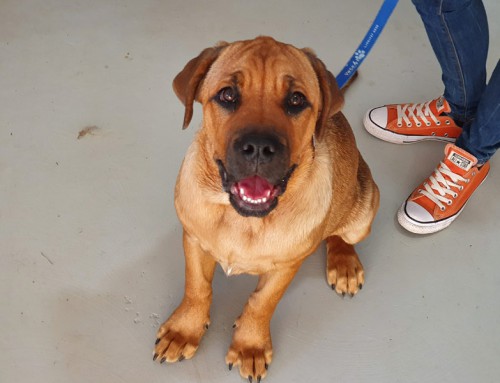We had considered fostering dogs for a long time before we took the leap. Our reasoning was not entirely altruistic – we had both grown up with dogs around and missed them terribly.
When your living a more nomadic lifestyle, or perhaps you’re just not ready to jump into a fifteen-year commitment with a furry thing the size of your pillow, fostering can appear as a mid-way option. An option that heartwarmingly saves lives, and gives you all day doggie-company (which we’re positive is a happinessbooster).
Earlier this year we found ourselves living in a new city, with not many commitments and plenty of time spent working at home, and realised that at least for now, we had the perfect conditions for giving much-needed love and care to a dog that would otherwise have a chance of ending up abandoned, or in a high killshelter.
So we took the leap and welcomed our first foster dog into our home.
Below are the tips we learnt along the way, that will help anyone fostering dogs or considering becoming a foster-family:
Prepare your home for your foster dog
Just like you would if you were bringing home a new puppy, preparing your home for your new foster dog or foster cat is essential. Often they’ll be frightened and insecure, either from a past history of abuse or from a tumultuous journey to your front-door (our foster dog came straight off a plane). Creating a warm and cosy spot where they can retreat into and relax undisturbed is always a good idea, and will help gradually ease them into their surroundings.
Soon after our foster dog Izzy arrived, we realised we should have done a bigger tidy-up and moved some of the small objects floating about to higher shelves. Like many dogs, Izzy was keen collector of random items. Doing a quick check for loose power cords, shoes and underwear will save you from having to buy new ones when you discover them torn up in a bout of doggie-delight.
Call on your inner patience
So perhaps you set up that cosy spot for your foster dog or cat, only to find they just won’t leave it? Foster animals can often require a little more patience than your usual furry pet. Keep in mind this may have been because of past traumas, and that with a little love and a lot of time, you can be the person to help them into a happier stage of their lives. Izzy walked in our front door naturally affectionate and seemed determined to make friends with every person she met, however a lot of foster dogs will be afraid and frightened. As well as giving them quiet time alone, sometimes it is just a matter of quietly sitting in the same room while they adjust to having people nearby and build-up some newfound confidence. When they’re ready for human contact, use your cuddles to reinforce their trust. If you’re really struggling to coax them out of their hiding place, food is often a trusty fallback method that will give them a tasty incentive to explore your home.
Be ready for some unusual dog-training
Foster dogs often haven’t had the training that other dogs would have experienced. This can mean they are a little more wild and mischievous than usual – but it doesn’t mean they can’t learn good behaviours. Mentally preparing yourself beforehand and giving yourself a chance to read up on tips for training puppies or older dogs and will put you on the front foot. We invested some time in training our foster dog Izzy for her future forever home, which put smiles on everyones faces when she was able to proudly follow all her basic commands on the day her family came to pick her up. (Fetching, however, was definitely a project for the future…). See more tips for training dogs here.
Keep in mind the reasons you had for fostering your dog
You hear about “foster failures” all the time – that is, people that foster dogs and end up not being able to part with them. Most of the time this is a happy story, and the dogs have found homes with people who love them and are 100% ready to do what it takes to give them the proper care they need. However, the temptation to adopt your foster dog can exist even when you are not in the right position to commit to taking care of them (well into their twilight years). Our emotional attachment to Izzy grew every time her floppy ears perked up in excitement, so we discovered it helped to keep in mind the reasons why we wouldn’t make a good ‘forever family’.
In our case, although she was a puppy when we fostered her, she was going to grow into a big dog (you can usually tell by the size of their paws – and hers were enormous). She would clearly soon outgrow our one-bedroom apartment. This prediction was backed up by the long walks we took her on, three times a day. At the end of the day, you could bet she was still skidding around on the floor with boundless energy.
Another reason we knew we weren’t a good long-term plan for our foster dog was our tendency to move around. Imagining the trauma of an international flight and a few weeks in customs (we all know how strict Australia’s biosecurity laws are after ‘that Johnny Depp’ incident) put a stop to our daydreaming.
Izzy needed a home with lots of space, grass to roll around in, not too many stairs, and most importantly, stability. Let’s add in there a family who would have the time to take her every day on exciting new (and we would suggest tiring) adventures. Luckily, within a few weeks, Izzy found exactly the right family. And that is the best part of fostering an animal – the happy end to the journey when you see foster dogs find the perfect forever family. Izzy is now known as Zizi, and brings a four-legged bundle of joy into the lives of her new family every day.
And us? Well, we’re just getting excited for the arrival of our next foster dog…







Leave A Comment